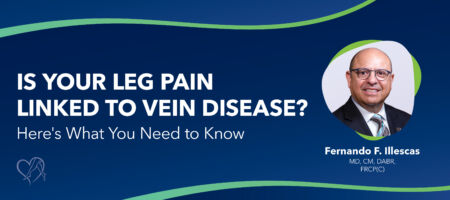
Medically reviewed by Fernando F. Illescas, MD, CM, DABR, FRCP(C), on September 10, 2025
Leg pain is one of the most common complaints people experience as they get older. It can sometimes be disregarded as muscle fatigue, arthritis, or a typical part of growing older. Other times, leg pain signifies a deeper issue: vein disease.
Also called chronic venous insufficiency (CVI), vein disease begins when the veins in your legs have trouble moving blood back up to the heart. Rather than flowing upward, blood can collect in the legs, causing pain, swelling, heaviness, and other uncomfortable symptoms. CVI can progress to more serious complications such as varicose veins, skin changes, or even venous ulcers if left untreated.
Curious if your leg pain might be linked to vein problems? In this blog, Fernando F. Illescas, MD, CM, DABR, FRCP(C), lead physician at Center for Vein Restoration (CVR) vein clinic in Waterbury, CT, walks you through symptoms to watch for, when to be concerned, and how to get help.
👉 If leg pain or swelling is holding you back from daily activities, schedule a consultation with CVR today to find out how vein disease might play a role. Call our Patient Services Representatives at 240-249-8250 or click below to book a consultation today at a CVR vein clinic near you.
📅 To schedule an appointment with Dr. Illescas in Waterbury, CT, CLICK HERE.
📅To schedule an appointment at any of CVR’s 120+ vein clinics nationwide, CLICK HERE.
Leg pain can have many sources, from sore muscles to joint issues. So how do you know when your veins are involved? According to the Cleveland Clinic, vein-related pain often has distinct features that set it apart, such as:
Another difference: unlike arthritis or muscle strain, which usually flare up during activity or first thing in the morning, leg pain from vein disease tends to build slowly throughout the day. This “end-of-day” pattern is one of the clearest indicators that circulation could be playing a role.
The bottom line? While arthritis and muscle strain can also limit daily activities, recognizing these distinctions helps patients and doctors determine whether the underlying cause is musculoskeletal or circulation-related.
Vein disease doesn’t just cause discomfort; it often changes the way your legs look and feel. If your pain is tied to circulation problems, you may also notice symptoms that come with visual cues, including:
These warning signs develop because blood isn’t moving efficiently back to the heart. When combined with ongoing leg pain, they strongly suggest vein disease may be the culprit.

Catching vein issues early can make treatment easier and more effective. Many people brush off small changes, but even these minor symptoms shouldn’t be ignored:
While these early signals may not stop you from living your daily life, they are often the first signs that CVI is beginning to develop. Being proactive simply by knowing these early signs can help minimize the risk of varicose veins, skin problems, and complications from vein disease altogether.
Everyone gets sore legs occasionally, but if your pain doesn’t improve quickly, it’s worth seeing a specialist. These signs suggest that vein disease may be progressing:
Remember: it’s essential to know the difference between early and further progressing vein disease. Even though some symptoms overlap, catching changes early can make treatment easier and more effective. Fortunately, modern treatments are safe, minimally invasive, and often performed in-office with very little recovery time.
If leg pain and circulation problems are holding you back, it’s time to take action. At Center for Vein Restoration (CVR), our nationally recognized vein specialists diagnose and treat vein disease with safe, minimally invasive procedures designed to restore comfort and confidence.
Don’t wait for symptoms to worsen! Schedule a consultation today and let CVR help you get back to healthier legs and a better quality of life.
📞 Call Center for Vein Restoration at 240-249-8250
📅 Or book online HERE
When you schedule a vein consultation at CVR, your vein physician will review your medical history, including your symptoms, family background, and daily habits. A physical exam comes next, focusing on visible signs such as varicose veins, swelling, or skin changes. In most cases, an ultrasound is also performed. It’s a simple, painless scan that shows how blood flows through your veins and identifies problem areas.
With this information, your CVR vein doctor can create a personalized treatment plan. Depending on your needs, options may range from home remedies such as compression therapy and lifestyle adjustments to outpatient procedures such as radiofrequency ablation, laser treatment, or sclerotherapy. These advanced techniques are highly effective at relieving pain, restoring circulation, and preventing future complications.
Even if medical treatment is needed, small changes in daily habits can go a long way in supporting healthy veins. Simple tips include:
While these steps won’t cure vein disease, they can ease physical symptoms and improve overall circulation, making medical treatments more effective.
Leg pain may seem like a small problem, but when it’s due to vein disease, it’s a warning sign that shouldn’t be ignored. Recognizing the clues, such as heaviness, swelling, or skin changes, can help you act before the condition progresses.
👉 Take the first step toward relief today. Schedule your consultation with CVR and find out if your leg pain is connected to vein disease. Call our Patient Services Representatives at 240-249-8250 or click the button below to book a consultation at a CVR vein clinic near you.

Can young people get vein disease?
Yes. While more common with age, younger adults, especially those with a family history, pregnancy, or jobs requiring long periods of standing, can develop vein issues.
Do men get vein disease, too?
Absolutely. Though varicose veins are often associated with women, men experience vein disease frequently but are less likely to seek treatment.
Are vein treatments painful?
Professional vein treatments are minimally invasive, performed in-office, and require little downtime. Most patients return to normal activities within a day or two.
